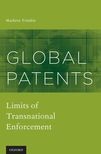 Global Patents: Limits of Transnational Enforcement
Global Patents: Limits of Transnational Enforcement
Contents
Cite
Abstract
This concluding chapter begins with a discussion of the process of patent law internationalization. Patent law internationalization has made tremendous progress, which has improved the position of inventors who strive to protect their inventions in multiple countries or worldwide. However, the process has fallen short of providing viable worldwide protection that will reward inventors for the global disclosure of their inventions. Patent law internationalization to date has developed in three stages. The first stage began in the 1870s and resulted in countries giving foreigners the right to obtain patents under the same conditions as their own nationals. In the second stage countries created mechanisms for obtaining patents in multiple countries. The current (third) stage of patent law internationalization evidences the recognition by countries that international cooperation in the area of intellectual property cannot stop at granting rights in multiple countries; cooperation must embrace the effective enforcement of rights as well. The chapter then considers proposed solutions to the problems of cross-border enforcement and patent law harmonization.
Sign in
Personal account
- Sign in with email/username & password
- Get email alerts
- Save searches
- Purchase content
- Activate your purchase/trial code
- Add your ORCID iD
Purchase
Our books are available by subscription or purchase to libraries and institutions.
Purchasing information| Month: | Total Views: |
|---|---|
| November 2022 | 5 |
| December 2022 | 6 |
| January 2023 | 2 |
| March 2023 | 2 |
| April 2023 | 2 |
| May 2023 | 5 |
| July 2023 | 2 |
| October 2023 | 2 |
| November 2023 | 1 |
| December 2023 | 4 |
| May 2024 | 2 |
| July 2024 | 2 |
| October 2024 | 4 |
| December 2024 | 3 |
| January 2025 | 2 |
| February 2025 | 1 |

Get help with access
Institutional access
Access to content on Oxford Academic is often provided through institutional subscriptions and purchases. If you are a member of an institution with an active account, you may be able to access content in one of the following ways:
IP based access
Typically, access is provided across an institutional network to a range of IP addresses. This authentication occurs automatically, and it is not possible to sign out of an IP authenticated account.
Sign in through your institution
Choose this option to get remote access when outside your institution. Shibboleth/Open Athens technology is used to provide single sign-on between your institution’s website and Oxford Academic.
If your institution is not listed or you cannot sign in to your institution’s website, please contact your librarian or administrator.
Sign in with a library card
Enter your library card number to sign in. If you cannot sign in, please contact your librarian.
Society Members
Society member access to a journal is achieved in one of the following ways:
Sign in through society site
Many societies offer single sign-on between the society website and Oxford Academic. If you see ‘Sign in through society site’ in the sign in pane within a journal:
If you do not have a society account or have forgotten your username or password, please contact your society.
Sign in using a personal account
Some societies use Oxford Academic personal accounts to provide access to their members. See below.
Personal account
A personal account can be used to get email alerts, save searches, purchase content, and activate subscriptions.
Some societies use Oxford Academic personal accounts to provide access to their members.
Viewing your signed in accounts
Click the account icon in the top right to:
Signed in but can't access content
Oxford Academic is home to a wide variety of products. The institutional subscription may not cover the content that you are trying to access. If you believe you should have access to that content, please contact your librarian.
Institutional account management
For librarians and administrators, your personal account also provides access to institutional account management. Here you will find options to view and activate subscriptions, manage institutional settings and access options, access usage statistics, and more.